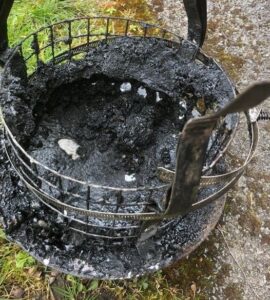What is Creosote?
In short creosote is essentially a by-product of incomplete combustion: leaving behind deposits of unburned and flammable tar vapours from wood smoke. Creosote is sometimes crusty or flaky in texture, but it can often be sticky or hard. Creosote deposits can be very challenging to remove from chimneys and unfortunately it poses a serious fire hazard, so it is important that a professional chimney sweep takes a look as soon as possible.

Contrary to popular belief, creosote is not actually an inevitable result of wood burning. The substance only forms when the wood is not burnt completely, and it can be an indication of improper use, poor installation, or a poorly designed wood burning stove. In other words the formation of creosote can be completely avoided.
It is important to note that if you have a build-up of creosote in your chimney, have it swept by a professional and ask the chimney sweep to help you to identify the cause so that you can prevent it from happening again. In this case prevention is very much better than cure so once your chimney is creosote free you will want to take measures to keep it that way.
What are the possible causes of creosote build-up?
Keeping the burn rate of your wood burning stove too low.
You need to keep the fire burning at an active rate, if you close the air off to the stove for a long but low burn you will create a smoky fire. This smoke creates lots of vapours that will become condensed inside the pipe or flue due to the relatively low temperature of the gasses.This is the main reason we advise against slumber burning overnight
To check how active your fire is burning the simplest solution is to simply go outside and have a look at the flue. If there is lots of smoke billowing from the chimney the chances are you are actually burning it too low. By burning it higher you will get more heat from the same amount of wood which will save you money, remember creosote is simply unburned fuel!
Using the wrong type of fuel.
When choosing your wood ensure that you select only well-seasoned, untreated, dry wood. Your wood should have a moisture content of less than 25% to help prevent the build-up of creosote. It is useful to remember that on average it takes around 12 months to fully dry out an inch depth of wood. Be sure to purchase your wood from quality, reputable suppliers, your chimney will thank you for it!
Oversized flue or improper connection.
It is essential that smoke escapes quickly and efficiently through the flue, if the flue is oversized or has too many elbows in the stove pipe, this can significantly reduce the speed of which the smoke stays in the venting system. If smoke ends up condensing this will cause an accumulation of creosote, so it is a good idea to avoid this at all times.
It is advisable to connect your stove to a liner, this is because stoves are usually designed to work on a 6-inch outlet, connecting your stove to a 9-inch square brick is always going to cause creosote problems and needs resolving professionally. It will be even worse if connected to a large inglenook type chimney
Safety First
Its not just Chimney sweeps that warn you of the dangers of slumber burning (burning at night time), Devon and Somerset Fire Rescue Service also state the following advice;
The most common causes of chimney fires are:
- Infrequent sweeping and cleaning
- Burning unseasoned wood
- Improper appliance sizing
- Overnight burning or smouldering wood for long periods in wood stoves.
If you are concerned about creosote build-up or have not had your chimney swept in the last three months, please don’t delay – Give us a call on 01626 832051 and let us get your chimney back to tip top safe condition.